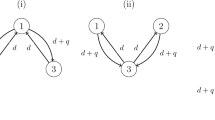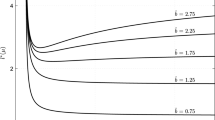Abstract
Many species live in advective environments, such as rivers or streams. The community composition in such environments is shaped by the interplay between biotic interactions and hydrologic constraints. Lutscher et al. (Theor. Popul. Biol. 71:267–277, 2007) demonstrated by simulation that advective flow can shift competitive outcome from one species dominating to coexistence or even to the other species dominating. Here, we present a detailed analysis of the Lotka–Volterra advection-diffusion model underlying their simulations. We use variational techniques as well as a spatially implicit approximation to determine all possible advection-induced shifts in competitive outcome. We show that changes in advection follow relatively few and predictable paths. We illustrate our results in various bifurcation diagrams.










Similar content being viewed by others
References
Bailey, J., & Ollis, D. (1986). Biochemical engineering fundamentals. New York: McGraw-Hill.
Ballyk, M., & Smith, H. (1998). A flow reactor with wall growth. In M. A. Horn (Ed.), Mathematical models in medical and health science (pp. 17–28). Nashville: Vanderbilt University Press.
Ballyk, M., & Smith, H. (1999). A model of microbial growth in a plug flow reactor with wall attachment. Math. Biosci., 158, 95–126.
Ballyk, M., Dung, L., Jones, D. A., & Smith, H. (1998). Effects of random motility on microbial growth and competition in a flow reactor. SIAM J. Appl. Math., 59(2), 573–596.
Berestycki, H., Diekmann, O., Nagelkerke, C., & Zegeling, P. (2009). Can a species keep pace with a shifting climate? Bull. Math. Biol., 71(2), 399–429.
Boldin, B. (2007). Persistence and spread of gastro-intestinal infections: the case of enterotoxigenic escherichia coli in piglets. Bull. Math. Biol., 70(7), 2077–2101.
Cantrell, R. S., & Cosner, C. (2003). Spatial ecology via reaction-diffusion equations. Mathematical and computational biology. New York: Wiley.
Cruywagen, G., Kareiva, P., Lewis, M., & Murray, J. (1996). Competition in a spatially heterogeneous environment: modelling the risk of spread of a genetically engineered population. Theor. Popul. Biol., 49(1), 1–38.
Grover, J., Sze-Bi, H., & Feng-Bin, W. (2009). Competition and coexistence in flowing habitats with a hydraulic storage zone. Math. Biosci., 222, 42–52.
Hershey, A., Pastor, J., Peterson, B., & Kling, G. (1993). Stable isotopes resolve the drift paradox for baetis mayflies in an arctic river. Ecology, 74, 2315–2325.
Huisman, J., Arrayás, M., Ebert, U., & Sommeijer, B. (2002). How do sinking phytoplankton species manage to persist. Am. Nat., 159, 245–254.
Jin, Y., & Lewis, M. (2011). Seasonal influence on population spread and persistence in streams: critical domain size. SIAM J. Appl. Math., 71, 1241–1262.
Lutscher, F., & Lewis, M. A. (2004). Spatially-explicit matrix models. A mathematical analysis of stage-structured integrodifference equations. J. Math. Biol., 48, 293–324.
Lutscher, F., & Seo, G. (2011). The effect of temporal variability on persistence conditions in rivers. J. Theor. Biol., 283, 53–59.
Lutscher, F., Pachepsky, E., & Lewis, M. (2005). The effect of dispersal patterns on stream populations. SIAM Rev., 47(4), 749–772.
Lutscher, F., Lewis, M., & McCauley, E. (2006). The effects of heterogeneity on population persistence and invasion in rivers. Bull. Math. Biol., 68(8), 2129–2160.
Lutscher, F., McCauley, E., & Lewis, M. (2007). Spatial patterns and coexistence mechanisms in rivers. Theor. Popul. Biol., 71(3), 267–277.
Lutscher, F., Nisbet, R., & Pachepsky, E. (2010). Population persistence in the face of advection. Theor. Ecol., 3, 271–284.
Müller, K. (1954). Investigations on the organic drift in North Swedish streams (Technical Report 34). Institute of Freshwater Research, Drottningholm.
Pachepsky, E., Lutscher, F., Nisbet, R., & Lewis, M. A. (2005). Persistence, spread and the drift paradox. Theor. Popul. Biol., 67, 61–73.
Potapov, A., & Lewis, M. (2004). Climate and competition: the effect of moving range boundaries on habitat invasibility. Bull. Math. Biol., 66(5), 975–1008.
Samia, Y., & Lutscher, F. (2010). Coexistence and spread of competitors in heterogeneous landscapes. Bull. Math. Biol., 72, 2089–2112.
Sherratt, J. (2005). An analysis of vegetation stripe formation in semi-arid landscapes. J. Math. Biol., 51, 183–197.
Skellam, J. (1951). Random dispersal in theoretical populations. Biometrika, 38, 196–218.
Speirs, D., & Gurney, W. (2001). Population persistence in rivers and estuaries. Ecology, 82(5), 1219–1237.
Strohm, S., & Tyson, R. (2011). The effect of habitat fragmentation on cyclic population dynamics: a reduction to ordinary differential equations. Theor. Ecol.
Van Kirk, R. W., & Lewis, M. A. (1997). Integrodifference models for persistence in fragmented habitats. Bull. Math. Biol., 59(1), 107–137.
Vasilyeva, O. (2011). Modeling and analysis of population dynamics in advective environments. Ph.D. thesis, University of Ottawa.
Vasilyeva, O., & Lutscher, F. (2010). Population dynamics in rivers: analysis of steady states. Can. Appl. Math. Q., 18(4), 439–469.
Vasilyeva, O., & Lutscher, F. (2012). Competition of three species in an advective environment. Nonlinear Anal., Real World Appl., 13(4), 1730–1748.
Acknowledgements
We are grateful for insightful discussions with Mark Lewis, Alex Potapov, Roger Nisbet, and Ed McCauley. This work was supported by an Early Researcher Award from the Ontario Ministry of Research and Innovation to FL, and by the University of Ottawa. We also thank an anonymous reviewer for many helpful comments, in particular, for the ideas of proofs in Propositions 2.2(b) and 2.5, and for suggesting Remark 2.10.
Author information
Authors and Affiliations
Corresponding author
Rights and permissions
About this article
Cite this article
Vasilyeva, O., Lutscher, F. How Flow Speed Alters Competitive Outcome in Advective Environments. Bull Math Biol 74, 2935–2958 (2012). https://doi.org/10.1007/s11538-012-9792-3
Received:
Accepted:
Published:
Issue Date:
DOI: https://doi.org/10.1007/s11538-012-9792-3




